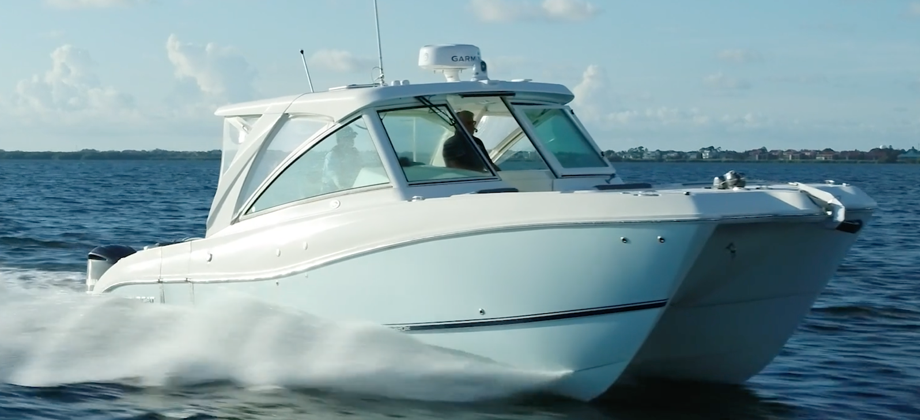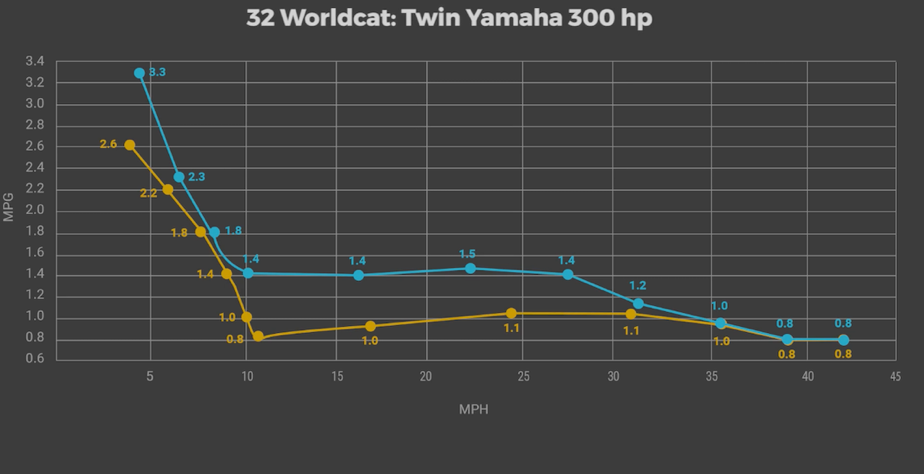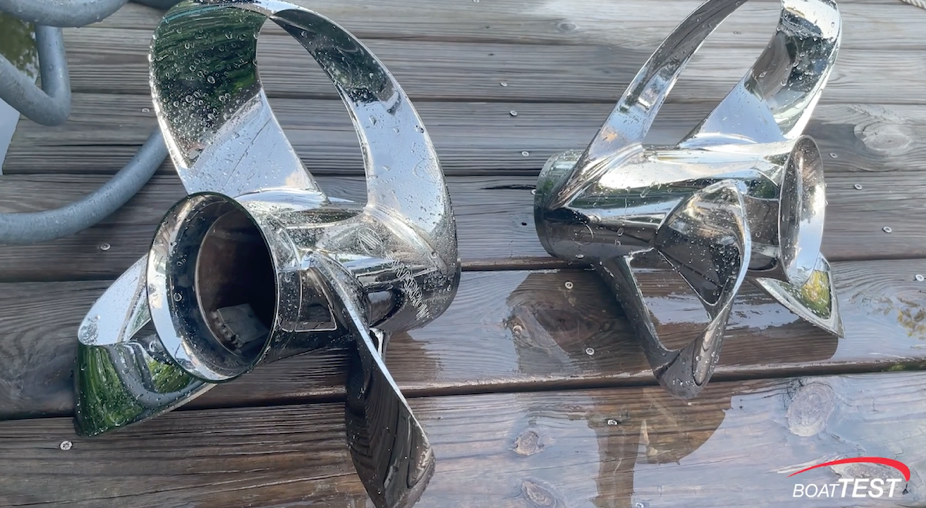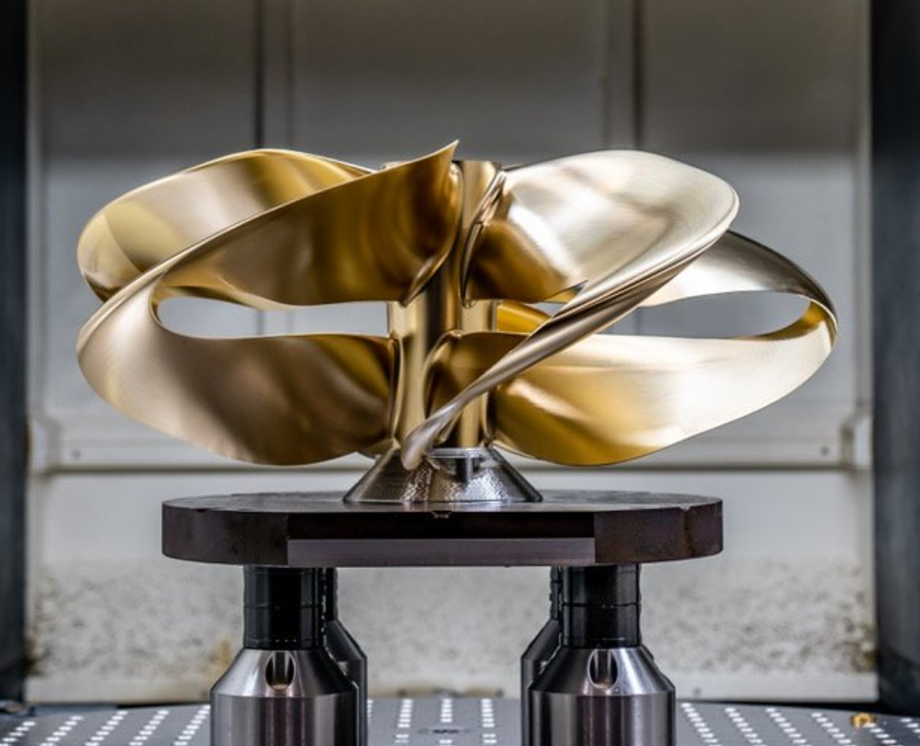What You Need to Know About Boat Propellers, Part 2: The Sharrow Propeller

There are not many innovative products because there are not many true innovators.
The Sharrow Prop, invented some seven years ago by Greg Sharrow and now manufactured by his company, Sharrow Marine, appears to be a true innovation in marine propulsion, perhaps the most important advance in propeller design in the almost 200 years since the boat propeller was invented.
While that sounds like company hype we’ve all heard before, independent tests thus far bear out the performance of the patented propeller.
The Sharrow propeller, designated as a “loop” propeller because the blades form metal loops with no evident tips as in conventional boat propellers, effectively has six interconnected blades woven almost like a ribbon around the barrel of the prop. It looks like a piece of sculpture rather than a functional mechanical device — but function it does, at a level that has been astounding the industry for the last several years.
BoatTEST’s head of testing Capt. Steve counted himself among those with some doubts that any propeller could produce the sort of results claimed by Sharrow, but after several of the most extensive, in-depth tests BoatTEST has ever conducted, he’s become a believer.
Specifically, the Company Claims That its Props Produce:
- More command of the vessel when docking
- Planing at 500-1000 lower rpm
- Significant speed increase at mid-range rpms
- As much as 30% more efficiency between 2500-4000 rpm
- Up to 30% greater range
- Noticeably less vibration
- Up to 50% more reverse thrust
- Quieter operation at planing speeds
- Superior handling in tight turns at high speeds

While all of this together presents a seemingly unlikely quantum leap forward in propeller design, BoatTEST’s independent tests thus far appear to have proven all the claims are true.
BoatTEST first tested the Sharrow on a generic 20’ (6.1 m) bowrider with a single 150-hp Mercury four-stroke outboard in 2019. The Sharrow was put up against two different conventional propellers, a 14-3/4” by 15” (37.46 cm x 38.1 cm) and a 15” by 15” (38.1 cm x 38.1 cm). View the test here: https://boattest.com/Sharrow-Engineering-Propeller
The results were so complimentary that some readers questioned whether the boat and engine combination might have accidentally happened to be a “sweet spot” for the Sharrow propeller.
Late in 2021, BoatTEST’s team agreed to do a more extensive test, eliminating as many variables as possible to assure impartial results.
The week-long process turned out to be the most in-depth testing ever done by the team, with computerized speed and fuel flow averaging used for the first time in the process.

Here are the conclusions from the tests on a World Cat 325 with twin Yamaha 300 four-strokes with conventional Yamaha SWS II stainless steel three-blade propellers compared to Sharrow’s 15.5" x 15.4" (40.01 cm x 38.1 cm) SS propellers:
- Performed significantly better at idle
- Planed at a lower RPM
- Were faster at all RPM settings
- Got significantly more mpg at 3000 and 3500 RPM
- Were more fuel efficient at every speed through water setting
- Were as much as 18% more fuel efficient at 26-28 MPH
- Produced the highest top speed
- Created noticeably less vibration
- Were generally quieter
- Had superior handling in tight turns at high-speed
- Improved handling in reverse
- Provided the greatest range at all speeds
Read the full Captain’s Report from BoatTEST.com HERE.
In short, BoatTEST reported that the Sharrow was faster at all rpm settings, planed with less rpm, had more reverse thrust, gripped the water better in turns and had better mpg readings at nearly every speed, particularly in the midrange.
Taking a look at some other numbers, at idle, the Sharrow props were 24% more fuel-efficient. The international maritime agency ICOMIA estimates that a boat spends 40% of its duty cycle running at idle, so this could be important over time.
For those who spend many hours trolling, the difference would be a big plus in operating cost.

At 20 to 25 mph, the Sharrow’s maintained an advantage of 36% in miles per gallon and at 35 mph, the efficiency for both sets of propellers evened off. At WOT with the Yamaha propellers, we hit a top speed of 41.6 mph at 5900 rpm where we recorded 52.4 gph. With the Sharrow’s, we hit 42 mph at 5500 rpm and burned 53.9 gph. Both of these sets of figures were calculated to .8 mpg and nearly identical range.
From zero to 20 mph, the Sharrow’s were 2.2 seconds quicker. They maintained their advantage through 30 mph (1.8 seconds) and 40 mph (2.6 seconds).
The results are impressive, to say the least. BoatTEST’s Captain Steve Larivee has found the props actually result in significantly faster planing, better fuel economy and better top end, as well as providing very positive steering control in corners and in reverse.
The test also showed less vibration with the Sharrow props.
In summary, the Sharrow propellers planed solidly at 3000 rpm and were faster at all rpm. Capt. Steve felt they had more thrust in reverse, which improves low-speed maneuverability for a high-freeboard boat like the 325 DC. They also maintained their grip in tight turns and the crew reported less vibration across the power curve.

Sharrow MX™ Propellers are specifically designed and optimized for vessels with 150- to 450-hp outboard or sterndrive motors in both single and multi-engine configurations.
The outboard propellers are priced at $4,900 — about 8 to 10 times the price of a conventional stainless steel prop. But with many marine accessories now in this price range, adding Sharrow props to high-end boats is likely to become part of the amortized fitting-out process, as well as a standard option for those who expect to spend long hours trolling with multiple large engines.
The company also builds propellers from 27” (68.58 cm) to 34” (86.36 cm) in diameter for luxury yachts, workboats and ferries.
The most lucrative application of this radical new propeller will likely be on supertankers and other large commercial ships, where it can potentially save them millions of dollars a year in reduced fuel consumption per ship, but they are also a great fuel saver on large yachts and sportfishers, increasing potential range as well as reducing operating costs.

The Sharrow Care™ Protection Plan comes free with every consumer propeller purchase and covers the prop for damage that occurs during normal operational use for up to 12 months after the original date of delivery.
Greg Sharrow, the propellers’ inventor, has made agreements with three foundries in the U.S. Midwest to cast his props. His company is currently planning on doubling the number of CNC 5-axis routers needed to finish the props to within a tolerance of.003, something nearly impossible to achieve with standard-production cast props. The company expects to cast some 10,000 props next year.